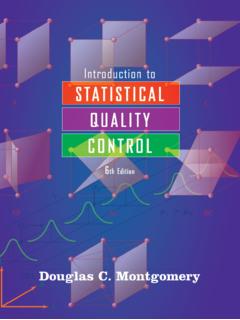Transcription of About the Tutorial - Current Affairs 2018, Apache Commons ...
1 Six sigma i About the Tutorial Six sigma is a methodology for pursuing continuous improvement in customer satisfaction and profit. It is a management philosophy attempting to improve effectiveness and efficiency. In this Tutorial , you will learn what Six sigma is and how to use Six sigma in an organization. Audience This Tutorial has been prepared for the beginners to help them understand the basic functionality of Six sigma . Prerequisites We assume the readers of this Tutorial have prior exposure to Quality Control and Quality Assurance and related terminologies. Copyright & Disclaimer Copyright 2018 by Tutorials Point (I) Pvt.
2 Ltd. All the content and graphics published in this e-book are the property of Tutorials Point (I) Pvt. Ltd. The user of this e-book is prohibited to reuse, retain, copy, distribute or republish any contents or a part of contents of this e-book in any manner without written consent of the publisher. We strive to update the contents of our website and tutorials as timely and as precisely as possible, however, the contents may contain inaccuracies or errors. Tutorials Point (I) Pvt. Ltd. provides no guarantee regarding the accuracy, timeliness or completeness of our website or its contents including this Tutorial . If you discover any errors on our website or in this Tutorial , please notify us at Six sigma ii Table of Contents About the Tutorial .
3 I Audience .. i Prerequisites .. i Copyright & Disclaimer .. i Table of Contents .. ii 1. SIX sigma INTRODUCTION .. 1 Features of Six sigma .. 1 Key Concepts of Six sigma .. 1 Myths About Six sigma .. 1 Benefits of Six sigma .. 2 Origin of Six sigma .. 2 2. SIX sigma KEY ELEMENTS .. 3 The Customers .. 3 The Processes .. 3 The Employees .. 3 3. SIX sigma ORGANIZATION .. 4 Leadership .. 4 Sponsor .. 4 Implementation Leader .. 4 Coach .. 4 Team Leader .. 5 Team Member .. 5 Process Owner .. 5 Extended Definitions of Roles Belt Colors .. 5 4. SIX sigma GET STARTED .. 6 Six sigma iii Is Six sigma Right for You? .. 6 The Cost of Six sigma Implementation.
4 6 Six sigma Start-up .. 6 Project Selection for Six sigma .. 7 5. SIX sigma METHODOLOGY .. 8 DMAIC Methodology .. 8 DMADV Methodology .. 8 DFSS Methodology .. 8 6. SIX sigma DEFINE PHASE .. 10 Project Team Formation .. 10 Document Customers Core Business Processes .. 10 Develop a Project Charter .. 10 Develop the SIPOC Process Map .. 10 Conclusion .. 11 7. SIX sigma MEASURE PHASE .. 12 Data Collection Plan and Data Collection .. 12 Data Evaluation .. 12 Failure Mode and Effects Analysis - 13 Yield to sigma Conversion Table .. 13 8. SIX sigma ANALYZE PHASE .. 17 Source Analysis .. 17 Process Analysis .. 17 Data Analysis .. 17 Resource Analysis.
5 17 Communication Analysis .. 18 Conclusion .. 18 Six sigma iv 9. SIX sigma IMPROVE PHASE .. 19 10. SIX sigma CONTROL PHASE .. 20 Quality Control .. 20 20 Control Methods and Alternatives .. 20 Responding when Defects Occur .. 20 Conclusion .. 21 11. SIX sigma TECHNICAL 22 Tool #1 The Critical to Quality (CTQ) Tree .. 22 Tool #2 The Process Map .. 22 Tool #3 The Histogram .. 22 Tool #4 The Pareto Chart .. 22 Tool #5 The Process Summary Worksheet .. 23 Tool #6 The Cause-Effect Diagram .. 23 Tool #7 The Scatter Diagram .. 23 Tool #8 The Affinity Diagram .. 23 Tool #9 The Run Chart .. 23 Tool #10 The Control Chart.
6 24 Conclusion .. 24 12. SIX sigma DEFECT METRICS .. 25 Defects Per Unit DPU .. 25 Total Opportunities 25 Defects Per Opportunity DPO .. 25 Defects Per Million Opportunities DPMO .. 25 How to Find Your sigma Level .. 25 Simplified sigma Conversion Table .. 26 Six sigma v 13. SIX sigma SUMMARY .. 27 14. SIX sigma GLOSSARY .. 28 Six sigma 1 Six sigma is a highly disciplined process that helps us focus on developing and delivering near-perfect products and services. Features of Six sigma Six sigma 's aim is to eliminate waste and inefficiency, thereby increasing customer satisfaction by delivering what the customer is expecting.
7 Six sigma follows a structured methodology, and has defined roles for the participants. Six sigma is a data driven methodology, and requires accurate data collection for the processes being analyzed. Six sigma is About putting results on Financial Statements. Six sigma is a business-driven, multi-dimensional structured approach for: o Improving Processes o Lowering Defects o Reducing process variability o Reducing costs o Increasing customer satisfaction o Increased profits The word sigma is a statistical term that measures how far a given process deviates from perfection. The central idea behind Six sigma : If you can measure how many "defects" you have in a process, you can systematically figure out how to eliminate them and get as close to "zero defects" as possible and specifically it means a failure rate of parts per million or perfect.
8 Key Concepts of Six sigma At its core, Six sigma revolves around a few key concepts. Critical to Quality: Attributes most important to the customer. Defect: Failing to deliver what the customer wants. Process Capability: What your process can deliver. Variation: What the customer sees and feels. Stable Operations: Ensuring consistent, predictable processes to improve what the customer sees and feels. Design for Six sigma : Designing to meet customer needs and process capability. Our Customers Feel the Variance, Not the Mean. So Six sigma focuses first on reducing process variation and then on improving the process capability. Myths About Six sigma There are several myths and misunderstandings surrounding Six sigma .
9 Some of them are given below: 1. SIX sigma INTRODUCTION Six sigma 2 Six sigma is only concerned with reducing defects. Six sigma is a process for production or engineering. Six sigma cannot be applied to engineering activities. Six sigma uses difficult-to-understand statistics. Six sigma is just training. Benefits of Six sigma Six sigma offers six major benefits that attract companies: Generates sustained success Sets a performance goal for everyone Enhances value to customers Accelerates the rate of improvement Promotes learning and cross-pollination Executes strategic change Origin of Six sigma Six sigma originated at Motorola in the early 1980s, in response to achieving 10X reduction in product-failure levels in 5 years.
10 Engineer Bill Smith invented Six sigma , but died of a heart attack in the Motorola cafeteria in 1993, never knowing the scope of the craze and controversy he had touched off. Six sigma is based on various quality management theories ( Deming's 14 point for management, Juran's 10 steps on achieving quality). Six sigma 3 There are three key elements of Six sigma Process Improvement: Customers Processes Employees The Customers Customers define quality. They expect performance, reliability, competitive prices, on-time delivery, service, clear and correct transaction processing and more. This means it is important to provide what the customers need to gain customer delight.



















